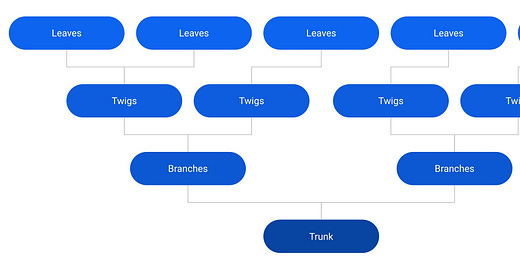Upstream: Lanaguage + Norms + Art*Technology = Generational Cohort
Tom Peters is one of my favorite management writers and thinkers. In the 80’s he helped popularize the concept of Management By Walking Around. As a people manager, I gained a healthy appreciation for the gemba walk. An antonym for the Metaverse, gemba is a Japanese term meaning "the actual place". Japanese TV reporters may refer to themselves as reporting from genba, or the scene of the crime. In total quality management, it is the place where value is created.
In a servant-leader mindset, I find it useful to turn the typical org chart upside down. Viewed as a tree, I think the organic metaphor is meaningful not only at the organizational level, but also for constituents of municipalities, states, and countries.
The roots may represent the board of directors or citizens. The chairman & executive officer is the trunk. Load-bearing branches are the C-suite or cabinet, twigs are decision-makers or people managers, and leaves are customer-facing staff or constituent services.
The leaves are creating or delivering a lot of value. The leaves complete the process of photosynthesis; front-line staff is in critical contact with sunlight from users.
The trunk’s role is to support the entire organization above it. Branches carry the responsibility of the weight of mortgages of dozens - if not hundreds - of twigs and leaves. In this view, the trunk may get very limited nourishment from the light of customers.
My mission to deliver value involves crawling all over branches, twigs, and leaves to align strategy and culture, prioritize drivers, and influence project teams. For digital and data products, that includes climbing all the way to the leaves in the gemba of daily stand-up.
At my first Parent-Teacher Association meeting, the principal shared with parents that the concept of school bells at the start of school or end of class was modeled after signals for shift change from the Industrial Revolution. Since then, the factory - and then office construct - has been a forcing function and physical aggregator of human capital.
For at least the last four decades, for knowledge workers in the service economy, the office (i.e. forcing function for human capital) was a venue owned/leased by the enterprise as a gathering place for employees to access systems, material, complete processes, hand off deliverables, and collaborate (if necessary).
The construct of the office served as a type of forcing function: a commercial real estate venue contracted/owned by the employer for staff to:
be in close proximity for serendipitous and spontaneous information sharing
share and benefit from the physical opportunity to collaborate
take advantage of perks intended to attract and retain talent
The Napster Generation across the world, but most acutely on the West Coast, internalized an important lesson from the Dot-Com boom-bust cycle: there was a serious potential to innovate and make a lot of money with internet technology.
For banking and financial services firms who define East Coast culture, the fall-out from over-extending credit and loosening risk guidelines during the 2000’s demanded cost savings in an existential Great Financial Crisis. Human capital with market insight, customer relationships, or user knowledge was incentivized to remain in high-cost of living areas. Meanwhile, middle and back-office functions were incentivized to move to places like Brooklyn, Jersey, Tampa, Phoenix, Buenos Aires, or Bangalore.
By disintermediating the front, middle, and back-office functions, regional and globally distributed teams equipped with access to teleconferencing, email, and chat technology safely completed complex, high-value, high-risk transactions to meet client satisfaction and government regulation. East Coast culture internalized a different lesson: there was serious potential to streamline and save a lot of money with internet technology.
Organizations actively took advantage of the now-distributed “digital gemba” and connected talent to costly, large-scale needs: the initial use case was call-center operators and customer service functions.
The intra-city, national, and global distribution of human capital was proven sustainable, reliable, and profitable.
For over a decade after the 2008-09 crisis, certain privileged talent was enfranchised or entrusted to work anywhere.
As a product person, I invent personas to explain phenomena and user behavior to myself and others. In this case, the persona of the S&P 500 C-suite or Fortune 500 senior executive lives in New Jersey, Westchester, Greenwich, Long Island, or their pied-à-terre on Park Avenue.
In my own experience across three Fortune 100 financial services companies, on Fridays, layers of corporate hierarchy model the behavior of the executive and also work from home. Fridays earn a reputation for being productive by not getting dragged into useless meetings, being able to schedule meetings back-to-back, or blocking off time to do actual work and complete deliverables. The popularization of open-floor plan office introduced cognitive load, distractions, and context-switching costs. For at least a decade, colleagues were aware that working away from the office could - and did - enhance productivity.
Until January and February of 2020, the machinery of various functions hummed along. The office environment was optimized for extroverted men who were perceived to create value.
Then, the digital gemba was atomized even further.
A public health emergency was declared. Chief Human Resources and Generals Counsel of the S&P or Fortune 500 convened and arrived at the conclusion that there was unquantifiable second and third-order risks to staff and management, which could impact business continuity of the enterprise. So, a decision was made. Knowledge workers in the service economy could continue doing their work. They just couldn’t do it at the office. They could do the work at home, where they lived.
More than two years later, organizations are still grappling with a distributed gemba, optimized for introverts, contemplating more criteria for organizational design: specific job functions, ergonomics, personality types, and commute times.
After enfranchising nearly everyone to the privilege, redefining norms for permission and tolerance, the Napster Generation reframed Work-Life Balance as Life-Work Balance.
Downstream: Ergonomic Hijinks




